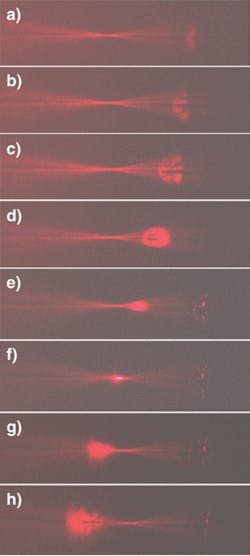ULTRAFAST TECHNOLOGY: 3-D movie shows femtosecond pulse propagation

For the first time, three-dimensional (3-D) images of femtosecond light-pulse propagation have been observed and recorded by researchers at the Kyoto Institute of Technology (Kyoto, Japan).1 The continuously moving pictures are produced using holographic light-in-flight techniques and enable the temporal and spatial analysis of femtosecond pulses for improving studies of ultrafast phenomena.
To record the image using the holographic technique, a scattering medium is usually required. In this experiment, the researchers used gelatin as a moderate 3-D scattering medium to visualize the path of light propagating within it; in addition, gelatin can be mixed with gum syrup and sugar to modify its refractive index.
The experimental setup to record the hologram divides a 720 nm, 224 fs pulse-width modelocked Ti:sapphire laser pulse into two light pulses by a beamsplitter, collimates them with a microscope objective and collimator lens, sends one pulse to the recording material (a holographic plate) at a 45° angle to its surface as a reference beam, and sends the second pulse to a glass container of gelatin at a 50° angle to its surface. When an ultrashort-pulsed laser is used in the holographic recording setup, interference fringes are recorded only where the object pulse-scattered by the gelatin-and the reference pulse arrive simultaneously in the recording material. Because the reference pulse obliquely illuminates the gelatin, the arrival time of the reference pulse at each point in the gelatin is different; therefore, a time-lapse image of the object is recorded along the lateral direction of the holographic plate. In short, the reference pulse acts as an ultrafast optical gate in recording a moving picture of the propagation of a single-shot pulse.
When the hologram is illuminated with a continuous light wave, each portion of the holographic image reconstructs the light pulse at a different point in time. By moving the point of observation along the lateral direction of the hologram, the temporally continuous moving picture of the image of the ultrashort light pulse can be observed. When a 100 ps phenomenon recorded on a 10-cm-long hologram is observed over a 1 s time period, a “temporal microscope” effect with 1010 magnification is achieved; the magnification is given by the ratio of the observation time to the actual time of the phenomenon. As the pulse width becomes shorter, a more detailed time evolution of the phenomenon is recorded, so the time resolution of the system improves. Due to the nature of the experimental setup and some specifics regarding optical path length, a right-to-left reversed image (the back side of the image) is observed.
To demonstrate 3-D imaging for a femtosecond pulse, a moving picture of a pulse as it converges and diverges through a convex lens was recorded (see figure). The basic experimental setup was slightly modified by adding a convex lens just before a mask attached to the glass container of gelatin.
Toshihiro Kubota, Kyoto Institute of Technology professor emeritus, and Yasuhiro Awatsuji, associate professor, are planning to apply this 3-D imaging technique to the observation of light propagation in photonic devices, light scattering in biomedical tissues and living cells, light propagation in the objects fabricated by laser processing, and in studying laser-induced ultrafast plasma evolution. “We are planning real-time observation of light propagation by introducing electronic and digital techniques (computer, imaging device such as CCD camera, and digital image processing) into the technique,” says Kubota and Awatsuji.
REFERENCE
1. T. Kubota et al., Optics Express15(22) 14348 (Oct. 29, 2007).
About the Author

Gail Overton
Senior Editor (2004-2020)
Gail has more than 30 years of engineering, marketing, product management, and editorial experience in the photonics and optical communications industry. Before joining the staff at Laser Focus World in 2004, she held many product management and product marketing roles in the fiber-optics industry, most notably at Hughes (El Segundo, CA), GTE Labs (Waltham, MA), Corning (Corning, NY), Photon Kinetics (Beaverton, OR), and Newport Corporation (Irvine, CA). During her marketing career, Gail published articles in WDM Solutions and Sensors magazine and traveled internationally to conduct product and sales training. Gail received her BS degree in physics, with an emphasis in optics, from San Diego State University in San Diego, CA in May 1986.